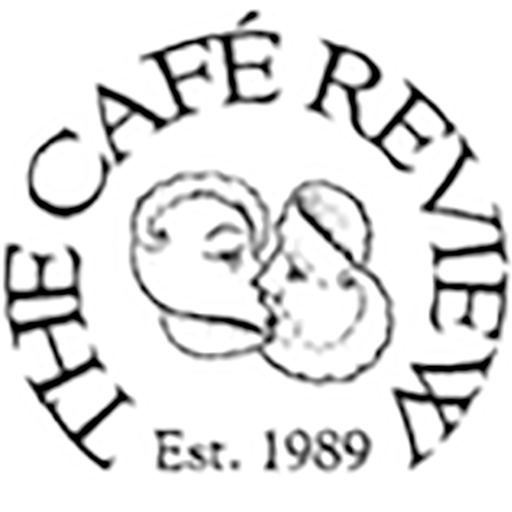Ellery Street

 by David Ferry,
by David Ferry,
Grolier Established Poets Series, 2015,
36 pages, $25 for the benefit of the Grolier Poetry Book Store,
ISBN# 978-0-98899352-3-5
Buy the Book
Bewilderment is the title of David Ferry’s last collection before his latest book, Ellery Street, and Ferry uses “bewilderment” to enact the language not only of old age, but of our entire human condition.
For example, consider this snippet of Ferry’s nearly completed Aeneid translation, parts of which were published in Bewilderment, which describes the soldiers coming out of the Trojan horse to disorient and overwhelm the city at night:
And then they enter the city that’s deep submerged in wine
and unknowing
sleep. . . .
Here, again, is the language of bewilderment in one of Ferry’s poems, “At the Lake,” in which he describes the lake not only as susceptible to climate change but also to emotional change:
It is a summer afternoon in October.
I am sitting on a wooden bench looking out at the lake
through a tall screen of evergreens,
Or rather, looking out of the plane of the lake,
Seeing the light shaking upon the water
As if it were a shimmering of heat.
Yesterday, when I sat here, it was the same,
The same displaced, out of season effect.
Seen twice it seemed a truth was being told.
The pitch-perfect ear that picks up something out of joint is now carried forward into Ferry’s new compilation, Ellery Street. In the preface, Ferry’s longtime friend and colleague Ifeanyi Menkiti describes some of these poems that have haunted Menkiti for half a century:
A lapsed awareness, or elapsed memory, will often come
back with your life, as if
the poems were saying that we are not yet done with our
days, that something else
is around the corner.
This compilation becomes an extended metaphor for and meditation on living in a place for a long time. That place, an historic house in which Ferry lived for over half his life, is the focus of this consciousness of living in a place.
Ferry and his late wife, Anne Ferry, were not the first poets to live there. Ellery Street was a house in Cambridge where Margaret Fuller had once rented a room, and where Emerson came to visit. But in this collection, the house is permeated by Ferry’s language of actual living, rather than any vestiges of Fuller or Emerson.
Beginning it in the reading room (isn’t it nice to have a room in your house that you call the reading room?), the poems move through a succession of vantage points, from the rooms to the street to the garden — often encountering neighbors and strangers walking around. The whole collection retains the view of living in a house next to others in a neighborhood, and perhaps even more interestingly, the poems in the collection become the rooms in the house and the areas surrounding the house.
Once we are thoroughly at home with the place of Ellery Street, inside and out, Ferry invokes classical figures — for example, Eurydice at the bus stop or Lazarus in his makeshift backyard camp — and thereby integrates ancient and modern figures into everyday roles. These allusions and translations, far from being off-putting, bring us more deeply into the life of the place and its surroundings.
A poem that brings together all the aspects living in Ellery Street is “Lazarus,” Ferry’s portrait of his homeless neighbor.
The dogheaded wildman sleeps in the back alley,
Behind the fence with bittersweet adorned,
In the corner of the garden over near
Where the viburnum flowers or fails to flower,
Depending on whether or not we water it.
Many times over again it has survived.
The leaves are homely, crudely rough-cut, with
A texture like sandpaper, an unluscious green,
Virtuous in look, not really attractive;
Like Kent in Lear plainspoken, a truth-teller,
Impatient with comparison as with deceit. . . .
The peaceful portrait of Lazarus sleeping among the viburnum blends perfectly with the poems that precede and follow it; it is at the center of Ferry’s universal care and understanding. He invokes Kent in King Lear, “plainspoken, a truth teller, / Impatient with comparison as with deceit.” The final image of Lazarus sleeping among the detritus of Ellery Street centers these poems.
This is in fact a perfect collection of poems, culled from Ferry’s other fine collections (Of No Country I Know: New and Selected Poems and Translations and Bewilderment). I say “perfect” because if the goal of poetry is to remind us what it means to be human in a certain place and time, then Ferry’s extended metaphor, Ellery Street, perfectly succeeds in this function.
— Mark Schorr
Cartographies of Scale (and Wing),
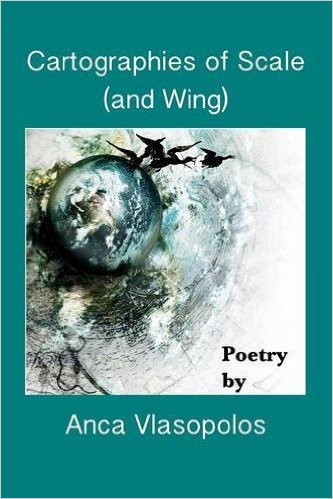
 by Anca Vlasopolos,
by Anca Vlasopolos,
Avignon Press, 2015,
91 pages, hard $16.95/paper $8.95,
ISBN# 978-0-9962920-1-6
Buy the Book
Cartographies of Scale (and Wing), Anca Vlasopolos’s third poetry collection, is an unnerving book — a warning. Her resounding concerns are with what humans do to the world, in our quest to explore, to conquer, and to exploit. For that, the thrust of this collection makes clear, is what humans have done through time: discovered new worlds, and then systematically destroyed them.
In the opening sections of her book, the poet writes to and about the scientists Gerardus Mercator (the creator of the Mercator projection map) and Samuel Bowditch (whose Bowditch Navigator revolutionized ocean navigation). These are, in her estimation, the men whose work enabled man’s conquering of the world. Yet Vlasopolos circles her subjects warily: Could these men have known what their work would lead to? She hints at this in “Mercator Makes Maps,” when, wondering how he came to his “geometric genius,” she asks:
was it a grape
you squashed
under
as you walked
pondering
the sphere
The violence Mercator has perhaps done to the world by metaphorically flattening it for the rest of human exploration becomes more obvious as Cartographies widens in scope. Vlasopolos writes of what the world has lost as humankind willfully tramples it underfoot. In “That and We,” the speaker, “exploring a stone’s throw / from a four-lane street,” reflects upon a progress which appalls her, with people who
hacked
cut
marked
chopped
sank dead posts
bound
kept out
The natural world of insects and birds with which the speaker has a natural affinity has been displaced, then lost. The poetry touches upon dwindling monarch butterfly populations in “At Water’s Edge”:
this year bereft of butterflies
these three
tatters
are left from plenty’s tapestry
It is the language of both beauty and despair, the plenty set in juxtaposition with the tatters left as the butterflies disappear from their habitats. Vlasopolos also writes of dwindling and extinct bird species, such as in the tragic “Empty Spoons,” where a southeast Asian family which formerly lived on birds caught for food now starves, as those birds’ habitats are replaced by “abandoned concrete walls.” The imagery of this collection is meticulous and ruthless.
Interesting, as well, is Vlasopolos’s use of white space in the structure of her poetry. So many times, in pieces such as the aforementioned “That and We,” she places lines on the page in ways that echo both the exploration and exploitation of the world about which she writes. Willful destruction is emphasized by short, hammering lines, pounding human constructions into the ground, or into the reader’s head. Gerardus Mercator, in “Mercator Makes Maps,” exists in lines that are snapped to the margins, much as he attempted to snap the world to lines of latitude and longitude, when he
nail[ed] to the wall
the shimmering
dress
of this
our
little globe
now emptied of loving roundness
left
naked
to probing
anatomizing
yet
to come
In nailing the lines to the margin, the poet makes more horrifying the metaphorical and subsequent rape of that “little globe.” In contrast to these left-justified lines, symbols of the natural world, such as the icebergs in “ID Denied,” float across the sea on the horizon:
four ice floes no
small icebergs maybe iceberg tips
moving west in blinding line of winter sunset
Structure, for Vlasopolos, is a favorite tool to support meaning; the readers get the that sense that for her, the world is open, save for when human progress closes it down — and for her, the danger of the world closing down entirely is imminent.
Mercator and Bowditch, Vlasopolos argues with layer upon layer of painstaking detail, opened the world for us. But rather than marvel at the wonders, we have destroyed them, and, as a result, are destroying ourselves. We are, she implies, blind in our arrogance, and in this collection, the poet (always the messenger who is scorned, or worse, ignored) hauntingly warns readers that
so much depends in each of these (to us) invisible links
upon our
staying
our hand.
— Anne Britting Oleson
From the New World, Poems 1976 –2014
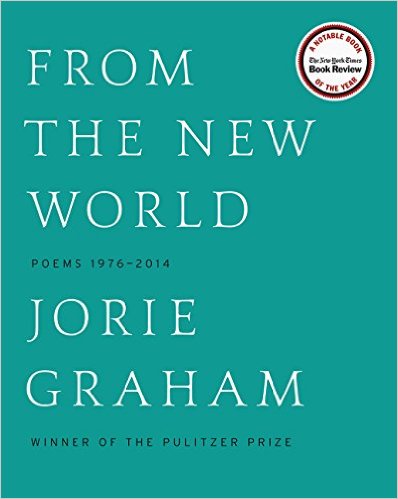
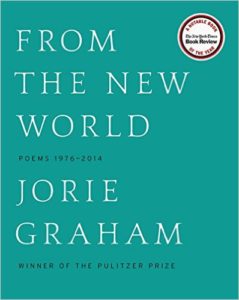 by Jorie Graham,
by Jorie Graham,
Ecco / HarperCollins Publishers, 2015,
384 pages, cloth, $29.99,
ISBN 9780062315403
Buy the Book
This is the heat that seeks the flaw in everything
and loves the flaw.
— Jorie Graham
In 1923, Marcel Duchamp referred to his work, The Bride Stripped Bare by her Bachelors, Even as a “delay in glass,” much like a “poem in prose” or a “spittoon in silver.” Suspicious of words and yet enamored with them too, Duchamp literally suspended an image in space and time; creating a “delay” — of arrival, of meaning, in relationship to representation, in relationship to an “indecisive reunion” as Calvin Tomkins named it in 1996. The amount of time you wait for something that is held back, a period of time in which something is postponed or slowed down, this delay in Duchamp’s work, as in the poet Jorie Graham’s, creates the conditions of desire.
The occasion of Graham’s new selected poems, From The New World, Poems 1976 – 2014, tracking nearly four decades of the Pulitzer Prize winner’s work, provides an eloquent opportunity to regard the specific obsessions and investigations, and the aesthetic and ethical development, of her work. The collection creates a new trajectory through her eleven volumes, and is rife with “delays” of the best kind: gaps and lulls and flaws that seek mending or to be knit, that seek connection and dialogue. Graham moves from using language to describe delay and its accompanying desire in her early work, toward creating the conditions of a delayed arrival for her reader in the structure of the poems themselves in later work. The later poems elicit a breathless haste in their desire to arrive at new meaning.
An early poem, the third in this collection, “The Geese,” from her first book Hybrids of Plants and Ghosts, takes place in a yard in Murray, Kentucky, where the speaker is hanging out wash beneath the migrations of geese, while spiders imitate the paths of the geese above “to no avail: / things will not remain connected, / will not heal.” In this gesture, “the world thickens with texture instead of history, / texture instead of place” and the longing to connect is a desire to help things “recover their meaning”:
There is a feeling the body gives the mind
of having missed something, a bedrock poverty, like falling
without the sense that you are passing through one world,
that you could reach another
anytime. Instead the real
is crossing you,
your body an arrival
you know is false but can’t outrun. And somewhere in between
these geese forever entering and
these spiders turning back,
this astonishing delay, the everyday, takes place.
In many of Graham’s poems throughout her oeuvre, the shuttle moves back and forth across these kinds of delays; the poems are filled with metaphors of weaving, stitching, and sewing, making a fabric of the page we navigate and the ideas and images she provokes. For example, in “Girl at the Piano,” the speaker says of the daughter:
. . . Your sleep beside me is the real,
the loom I can return to when all loosens into speculation.
Silently, the air is woven
by the terribly important shuttle of your breath,
the air that has crossed
your body retreating, the new air approaching.
In the poem, “Self Portrait as Hurry and Delay (Penelope at Her Loom),” from Graham’s third collection, Penelope enacts delay as a strategy for fending off suitors, weaving and unweaving the story cloth daily, doing and undoing, effectively suspending time, and holding the story — her life — in place. The poem unfolds in a series of twenty-three numbered sections that provide occasion
for breath within the poem, pauses within the unfolding narrative. They also begin to employ a layering technique that becomes more nuanced in Graham’s work over time, creating a stratigraphy and accumulation of meaning. In this poem, she begins to ask readers increasingly to fill in the gaps, to enter the text and engage the delays, to engage in the stitching and unstitching themselves. Graham asks, “Oh but is it wide enough to live on, immaculate present tense, lull / between wars, // the threads running forwards yet backwards over her stilled fingers,” and later, “Yet what would she have if he were to arrive?”
“Le Manteau de Pascal,” the poem at the center of her sixth book, The Errancy, and located at the center of this new collection, regards René Magritte’s 1957 painting of Pascal’s coat, the Surrealist image of a coat full of holes hovering in the night sky above a distant urban horizon. In the endnotes Graham says, “One presumes it represents the coat in which Pascal was buried, and in whose hem or sleeve or ‘fold’ the note containing the ‘irrefutable proof of the existence of God’ is said to have been stitched at his request, unread, by his sister upon his death.” This poem, too, unfolds in a series of sections, including excerpts from Hopkins’s journals and Magritte’s notebooks. The breaks between sections, and the leaps in content and meaning, again create the conditions for great intimacy and exchange within the text. As Graham notes, “The sky can analyze the coat because of the rips in it. // The sky shivers thought the coat because of the rips in it. // The rips in the sky ripen through the rips in the coat. // There is no quarrel.”
The final page and a half of this poem are tightly packed with phrases previously uttered in the eight-page poem. Through this sudden dense layering of lines, an accumulation and acceleration through material investigated before, a kind of “learning” occurs for the reader that creates an uncanny experience of déjà vu. Increasingly, Graham’s poems illicit a breathlessness as they careen toward their end, layer upon layer, at times creating a sort of panicked haste, a desire to encounter meaning, to arrive, to become “real.” As the poem ends, she notes, “ . . . floating in the air before us with stars a test case . . . I saw clearly the impossibility of staying.” The poem draws tightly in on itself like a jacket, across the gaps and holes, but the wind — the sky, the reader — can still move through it.
Acceleration in the poems is created through techniques such as listing and anaphora, and structurally, through the shape the poem takes on the page. Towards the end of this collection, the poem “Lull” creates a visual stratigraphy composed of long phrasal layers interspersed with a “core sample” of very short lines that run through the right side of the poem. Navigating both the horizontal of extended thought and the penetrating depth of rapidly moving, layered short lines, the poem deftly navigates the forest’s edge where a fox has come out into the open and stares at the speaker. The speaker contemplates “the dream / of ownership”; “How much / did you think you / could own,” the poem asks. The fox replies as the world is given voice in Graham’s poems:
— fox says
what a rough garment
your brain is
you wear it all over you, fox says
language is a hook you
got caught,
try pulling somewhere on the strings but no
they are all through you,
had you only looked
down, fox says, look down to the
road and keep your listening
up, fox will you not
move on my heart thinks checking the larder the
locks fox
says your greed is not
precise enough.
Through all the poems, there is an impulse to look with greater precision, deeper and longer, to not look away, but to engage war, climate change, our mortality, our gods and, too, to question our very presence on the planet. In this dialogue — this discourse — between self and other, real and metaphor, between known and unknown, history and the present, between fox and heart, geese and spiders, there is a constant desire for connection and to stitch together meaning, some kind of a garment we can wear, even if full of holes. And that garment seems to be made of language. Graham reminds us that this dialogue is where we connect, after all, and that “desire / is the honest work of the body, / its engine, its wind.”
— Julie Poitras Santos
Heliopause
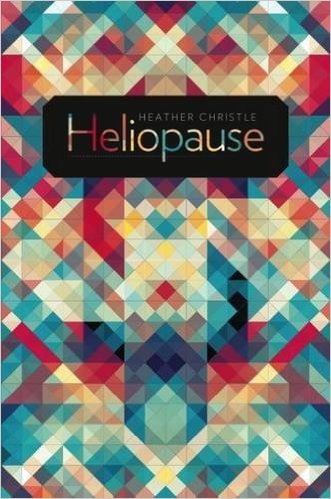
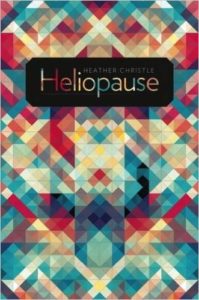 by Heather Christle,
by Heather Christle,
Wesleyan University Press, 2015,
112 pages, cloth, $24.95,
ISBN 978-0-8195-7529-6
Buy the Book
Heather Christle’s new book, her fourth, takes its name from a zone of transition: the edge of our solar system, where the Sun’s area of dominion shifts into interstellar space. As the book notes, the public was recently reminded of the heliopause when the Voyager spacecraft crossed it in 2013 on its way to deep space. The metaphor of a transition zone remains a striking presence throughout Heliopause, in which, against the backdrop of a dismantled space program, Christle makes record of personal and national loss.
Heliopause situates itself in a post-9/11 landscape that is not, in fact, very post- at all. The collection is organized around several sequences; the first, “Disintegration Loop 1.1,” is a compelling ekphrastic response to William Basinski’s September 11th footage and “decaying pastoral loop.” Drawing on the concept of challenging reflexive loops for conflict resolution, Christle wrote each morning for several weeks alongside Basinski’s video. The resulting sequence is a fascinating meditation on fear and falling, as well as the limits of structure and structures. In this procedure, “every morning the diminishing returns” and light is tempered with the trace of darkness.
Throughout the collection, Christle’s formal movements emphasize the repetition and randomness of loss. An erasure from the transcripts of the first moon landing, “Elegy for Neil Armstrong,” presents text in white against a black page, compressed into short articulations of presence. One of Christle’s gifts is the ability to express even the most abstract pain as personal, oscillating between a collective “we” and a personal voice to address Armstrong. “Neil,” she writes, “I’m with you / (garbled).” The epistolary “Dear Seth” reaches across a long-distance friendship, as does a poem for the late Bill Cassidy: “Hey Bill / where you are / do you see letters.” In each poem, Christle explores the use of language to frame each shifting circumstance of being, a tool to “consider” or “confess”:
Dear Seth
There is fear the baby
when it arrives will be wrongly
or poorly loved
that the world is no place
for helpless things
You will see
reading this through your good beard
how neatly
I have left myself out
though I understand
come spring
such grammar tricks
will no longer work
Christle’s striking honesty is tinged with the eeriness of public consciousness; a choice of movie times is driven by calculations of the likelihood of mass shootings, and even the lights themselves tremble. Each line asserts itself with a subtle elegance, reminiscent of Rae Armantrout, and an openness that allows the simplicity of life to be reflected in the lines: this morning worthy of significance as readily as meditations on the nature of mortality. Both life and language are bare and painful in Christle’s composition, and this precision allows us access to the speaker at her most vulnerable, and often most charming, moments:
in the winds
just remnants of the storm
that wouldn’t stay
I have thought
to run away from what I own
Who hasn’t
but what else do I have
Where would I go
The sky is everywhere
at once like a big movie
and though I think I know how
it’s going to end
and with what music
there is uncertainty enough
to hold me still
As the book progresses, the sense of complete envelopment in the “pathless field” is remarkable; Christle writes, “It’s the same problem / in any direction.” Yet despite the speaker’s assertions of her own “dumb” responses, what emerges here is a bright and thorough meditation on what it means to be inherently irresolute. With sincerity and intelligence, Christle’s book bravely seeks connection amidst chaos; in doing so, she offers a model for how to find meaning in the impossibly brief and immeasurable. Rather than seeking to dampen the impact of fear, these poems offer a nimble portrait of its daily iterations. In a time when we are distinctly aware of the limits of human intelligence and empathy, Christle’s Heliopause gives voice to an essential plea: “touch me / touch me.”
— Kate Partridge

